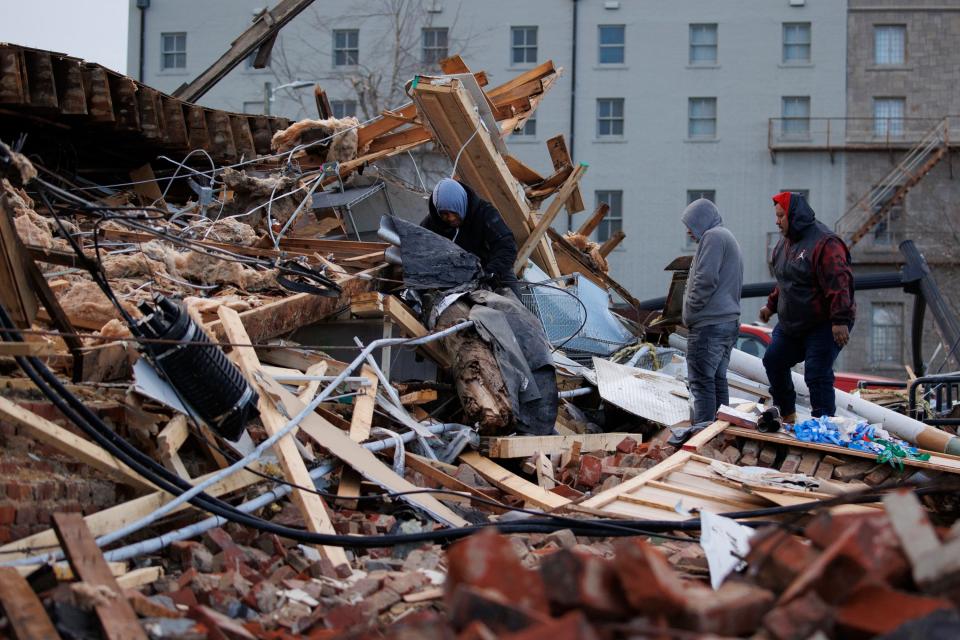Path of 'potentially historic' 5-state tornado may go down as longest in US
December tornadoes are uncommon but not unheard of. The explosion of twisters across five Midwest and Southern states over the weekend? That might be unprecedented.
The tornadoes that spun off a fast-moving storm Friday night and into Saturday morning probably killed more than 70 people in Kentucky alone, according to Gov. Andy Beshear, and at least 14 in the four other states.
A combination of the main tornado’s enormous path as it tore from Arkansas to Kentucky, its sheer power and the high number of smaller whirlwinds that accompanied it made for an overwhelming force that left devastated communities in its wake. The small city of Mayfield in the southwest corner of Kentucky suffered at least eight deaths at a candle factory.
“Tornadoes do happen at this time of year, but the number in which they happened and the intensity in which they happened Friday night is what is rare,” said Dan DePodwin, director of forecast operations for AccuWeather. “On average, in December, there are roughly two dozen tornadoes (nationwide). We’re going to surpass that just on the one night Friday.”
The exact number – believed to be at least 30 – and the scope of their damage won’t be known for several days as surveyors conduct assessments. "This is the deadliest tornado event we have ever had," Beshear said.
View of devastation: Drone footage shows tornado damage in Kentucky
'We were trapped': Kentucky candle factory survivors recount escape from deadly tornado
The Louisville Courier-Journal, part of the USA TODAY Network, reported the main tornado’s path extended for about 223 miles, four more than the record of 219 set by the so-called tri-state tornado on March 18, 1925, which ripped through parts of Missouri, Illinois and Indiana.
DePodwin said only one December tornado with a path length of at least 100 miles has been measured since record-keeping began in 1950, and just 17 of 50 miles or longer. Peak severe weather season usually runs from late February to early June.
Preliminary reports indicate the weekend’s mega-twister rated at least an EF3 on the Enhanced Fujita scale, which measures wind speeds and related damage and goes up to 5. An EF3 rating equates to winds of 136-165 mph, but the assessment could rise, depending on what surveyors find. The National Weather Services office in Paducah, Kentucky, estimated peak winds at 158-206 mph, again subject to change.

One indication that could happen was the main tornado’s estimated width of at least half a mile and possibly up to a mile, which usually correlates with enhanced power. Of the 1,200 or so tornadoes that hit the USA every year, on average, a mere six reach a mile in width.
“Some aspects of this event are potentially historic,” said Harold Brooks, senior scientist with the National Oceanic and Atmospheric Administration’s National Severe Storms Laboratory. “This was a very strong tornado that was on the ground for a really long distance. If it’s 200 miles, it’s in the top few in history.’’
That’s for any month, not just December. From 2010 to 2019, only four tornadoes stretched out for at least 100 miles, and none made it to 150.
'Completely devastated': Kentucky town left mourning, in ruins after catastrophic tornado
Relief funds, supplies and blood donations: How to help after Kentucky tornadoes
Warm, moist air near the ground, cool, dry air aloft and wind shear – changing speed and/or direction of the wind – contribute to the creation of tornadoes. Those elements tend to be less prevalent in late fall and winter – the least likely date for tornadoes in the USA is Dec. 31 – raising the question of the role climate warming may play in their formation.
Brooks said there has been an increase in winter tornadoes over the past 40 years in the area impacted by the weekend twisters but not in the country as a whole, and there’s little evidence their intensity has changed.
He and DePodwin agree the issue is far from resolved.
“The exact relationship between tornadoes and climate change is still a bit uncertain,” DePodwin said. “There’s a lot of science going on about that right now.”
This article originally appeared on USA TODAY: Longest tornado ever? Deadly twister that hit 5 states may set record

